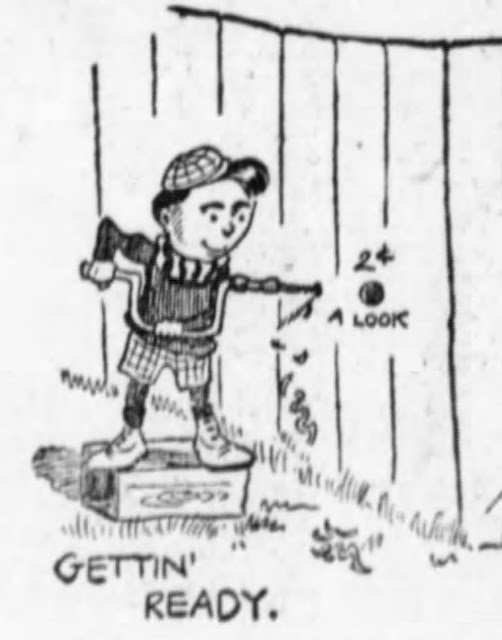Opening day in baseball always comes with great excitement and anticipation, but especially during a time of war, pandemic, economic uncertainty and political unrest. While that certainly is the human condition today, it was equally true of the Dead Ball Era (1901-1919), so called because of the lack of power hitting. The first two decades of the twentieth century saw the assassination of President William McKinley, the financial panic of 1907, the horrors of World War I, not to mention the deadly and even more pervasive Spanish influenza. Having "supped" thus "full of horrors," it's no wonder Brooklyn Dodger fans looked forward to opening day even though their team spent 15 of the 19 seasons mired in the second division. At a time when sports photography was in its youth, Brooklyn newspapers used high quality artwork to capture the spirit of opening day. What follows is a sample of those drawings, primarily from the better known Brooklyn Eagle, but also from the borough's other three daily newspapers, the Standard Union, Brooklyn Citizen and Brooklyn Daily Times.
Thursday, April 7, 2022
Opening Day Now and Then
Brooklyn Daily Eagle - April 21, 1911
Legendary baseball writer Roger Angell once described opening day games as "chilly inaugurals," a sentiment anyone who has endured a frigid early April afternoon in Boston or New York can appreciate. Although the season started later during the Dead Ball Era, frigid temperatures like those anticipated in the below April 14, 1904 Eagle drawing weren't uncommon. While the day began with snow flurries, it didn't keep some 20,000 fans from filling Washington Park only to suffer through a 7-1 loss to the Giants. Mercifully the game lasted only one hour and 42 minutes.
A recurring theme during this period and even earlier was how office workers had to unexpectedly miss work or leave early on opening day for reasons creatively designed to bring a sympathetic response from the boss. In 1890, the Boston Globe reported that in many offices "the faithfullest (sic) clerk bound crepe around his arm" and rushed off "to bury an old friend" while "the inoffensive office boy" took "his widowed mother to the dentist." Left on his own, "the deserted proprietor" had no alternative, but to join them. For the serious fan, it was no joking matter since in a world without radio and television, virtual attendance wasn't an option. The below ad from the Brooklyn Daily Eagle of October 11, 1916 actually refers to Brooklyn's sole World Series appearance of the period, but gives a sense of how common the scheme was in desire if not in practice.
One hopes the young man pictured in the below drawing from the Brooklyn Citizen of April 8, 1913 was rewarded for his honesty. After all, it wasn't just any opening day, but the Dodgers first regular season game at Ebbets Field.
The below map from the Standard Union of April 5, 1913 places Brooklyn's new ball park squarely at the epicenter of Brooklyn's baseball world. As convenient as Ebbets Field may have been by mass transit, anyone who believed the trip from Jersey City took only 30 minutes was also a likely potential buyer of the borough's best known bridge.
Regardless of how long the trip took, some rode the trolleys pictured below in the Eagle of April 12, 1916, the dodging of which supposedly gave the Brooklyn club its enduring name.
Dodger owner Charles Ebbets complained loud and long about the cost and unfairness of free passes. The below drawing also from the Eagle of April 12, 1916 suggests the paper's sports editor (a remarkable resemblance to Abe Yager, the real editor) felt his pain.
Some, of course, had less traditional ways not only to see the game, but to make money off of it. When this drawing appeared in the Brooklyn Daily Eagle of April 16, 1907, the Dodgers still played at Washington Park, a wooden structure so the possibility was not entirely fanciful.
In his essay "Why Time Begins on Opening Day," Tom Boswell described baseball as "a great therapeutic wash of fact and anecdote." The combination is depicted almost perfectly in the below, April 9, 1913 Eagle, drawing presumably of a grandfather and grandson at the first regular season game at Ebbets Field. The grandfather, who could easily have seen every opener since the team's 1883 founding, has the facts, perhaps embellished by anecdotes, while the grandson could have gone on to witness every Brooklyn Dodger opener thereafter. We'll assume the missing middle generation didn't have a creative excuse to miss work or an understanding boss.
The only way the missing father/son could even keep track of the score was when a newspaper, tavern or other place posted scores received from the park such as the below example from the Brooklyn Daily Eagle of April 12, 1916.
In the below drawing from the Eagle of April 14, 1908, Nelson Harding, the paper's Pulitzer Prize winning editorial cartoonist, captured the boundless optimism of opening day. Boundless, no matter how little reason there was for hope - at least on the baseball field. Not only had the Dodgers lost five straight home openers, they would lose again on this day, the first of over 100 losses and a next to last place finish. Yet opening day still brought hope that went far beyond the ball field, no matter how difficult the times. And that hopefulness is as real today as it was over a century ago. While it's tempting to speculate as to why a new baseball season has that kind of power, it's perhaps wise to remember Roger Kahn's admonition about not trying to summarize the 1951 National League pennant race. It was Kahn felt like attempting to summarize King Lear which would only "diminish majesty." So we'll let it go at that and just be grateful that once again baseball is back!
Subscribe to:
Post Comments (Atom)











Great stuff, John
ReplyDelete